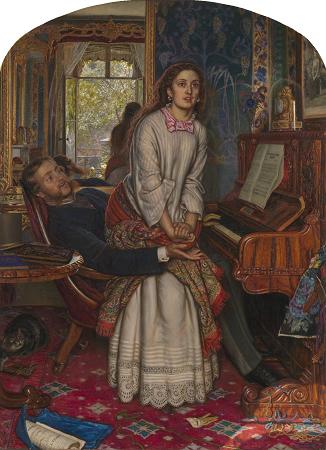
Awakening Conscience. The Awakening Conscience is an oil-on-canvas painting by the English artist William Holman Hunt, one of the founders of the Pre-Raphaelite Brotherhood, which depicts a young woman rising from her position in the lap of a man and gazing transfixed out of the window of a room.
The painting is in the collection of the Tate Britain in London. Initially, the painting appears to depict a momentary disagreement between husband and wife, but the title and a host of symbols within the painting make it clear that this is a mistress and her lover.
The woman's clasped hands provide a focal point and the position of her left hand emphasizes the absence of a wedding ring. Around the room are dotted reminders of her kept status and her wasted life: the cat beneath the table toying with a bird; the clock concealed under glass; a tapestry which hangs unfinished on the piano; the threads which lie unravelled on the floor; the print of Frank Stone's Cross Purposes on the wall; Edward Lear's musical arrangement of Tennyson's poem Tears, Idle Tears which lies discarded on the floor, and the music on the piano, Thomas Moore's Oft in the Stilly Night, the words of which speak of missed opportunities and sad memories of a happier past.
The discarded glove and top hat thrown on the table top suggest a hurried assignation. The room is too cluttered and gaudy to be in a Victorian family home; the bright
The painting is in the collection of the Tate Britain in London. Initially, the painting appears to depict a momentary disagreement between husband and wife, but the title and a host of symbols within the painting make it clear that this is a mistress and her lover.
The woman's clasped hands provide a focal point and the position of her left hand emphasizes the absence of a wedding ring. Around the room are dotted reminders of her kept status and her wasted life: the cat beneath the table toying with a bird; the clock concealed under glass; a tapestry which hangs unfinished on the piano; the threads which lie unravelled on the floor; the print of Frank Stone's Cross Purposes on the wall; Edward Lear's musical arrangement of Tennyson's poem Tears, Idle Tears which lies discarded on the floor, and the music on the piano, Thomas Moore's Oft in the Stilly Night, the words of which speak of missed opportunities and sad memories of a happier past.
The discarded glove and top hat thrown on the table top suggest a hurried assignation. The room is too cluttered and gaudy to be in a Victorian family home; the bright
Wikipedia ...